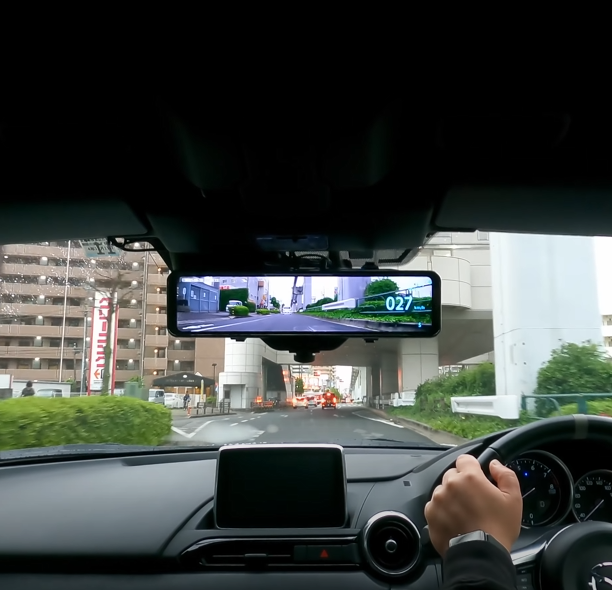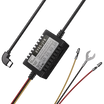A Dashcam is a must-have that not only keeps a driver safe but protects a company from false insurance claims and other liabilities.
If you own a dash cam or planning to purchase one, but have no idea how to install it, this guide can help.
Those who fail to install a dashcam properly find themselves disregarded by insurance companies and law enforcement, and may even face legal action.
There are strict regulations regarding the placement of in-car equipment. Dash cams, for example, should be installed in a way that does not obstruct the driver's view.
So before you hit the road with your new gadget, let’s discuss how to set it up for optimal coverage. We’ll start by choosing one.
1. Choose the Ideal Dash Cam For Your Vehicle
Dash cams are available in the following categories;
They come in front-facing, front and rear models, and high-end 360-degree cameras such as the Akeeyo AKY-V360S, which offers an all-around view of the car’s interior, perfect for taxis or ridesharing drivers.

When selecting a dash cam, some key features to consider are;
- G-sensors: Automatically record and lock footage during collisions.
- Parking Mode: Monitors the car while parked, detecting impacts or motion.
- Loop Recording: Continuously records old footage when the memory card is full.
- Night Vision: Ensures clear recording in low-light conditions.
However, proper installation is crucial for these features to function effectively.
2. Pre-Installation Instructions
Here is what you will need to do before you install a dash cam for a hitch-free process.
Gather Tools and Equipment
Make sure you have all necessary tools before starting: a suction mount or adhesive pads for attaching the camera, a cable clip to manage to wire, and try tools to safely remove panels if you plan to conceal wires.
Check Legal Regulations
According to research, 12 US states forbid mounting objects on windshields. In eight other states (16%), you cannot attach anything to your windshield, mostly in areas unsuitable for dash cams. Also, it is prohibited to install the camera in a way that will block the driver’s line of vision, although it is generally best to place the camera behind the rearview mirror.
3. Dash Cam Installation in Cars
You have to follow these simple steps when Installing a dash cam in your car to ensure optimal coverage and performance.
Step 1: Select the Optimal Position

Front Windshield: Place the front dash cam behind the rearview mirror, centered, to avoid blocking your view and capture wide coverage.
Rear Dash Cam: For rear coverage, install it at the top-center of the rear windshield for balanced footage.
Step 2: Clean the Installation Area
Clean the windshield so the suction cup or adhesive sticks well and the dash cam stays secure.
Step 3: Mount the Dash Cam
Suction Mount: To get the best view, attach the suction cup to the windshield and then adjust the camera's angle.
Adhesive Mount: For a firm hold, carefully place and push the mount.
Step 4: Route the Power Cable
Tuck the wires neatly using a pry tool along the headliner and A-pillar. Connect to a power source via the 12V socket, fuse box, or OBD port.
Step 5: Test the Dash Cam
You can now turn on the dash cam to check the view and make necessary adjustments to ensure clear, well-centered footage.
Step 6: Adjust The Camera Angle.
Make sure the camera captures a clear view of the road ahead or behind, adjusting as needed. The horizon is level, and neither the sky nor the dashboard should take up too much of the frame.
4. Dash Cam Installation on Motorcycles
If you are looking to install your dash cam on motorcycles for the best coverage and safety, then follow these given steps.
Step 1: Select the Optimal Position
Mount the front camera on the handlebars, helmet, or near the headlights for a clear view. Place the rear camera under the seat or near the rear lights.
Step 2: Secure the Mount
Use a sturdy, weather-resistant mount for motorcycles to handle vibrations and rough conditions.
Step 3: Connect to Power
Wire the dash cam directly to the battery or fuse box. Ensure waterproof connections and protect cables from moisture.
Step 4: Route the Cables
Run cables along the frame, avoiding hot engine parts and moving components to prevent damage.
Step 5: Test and Adjust
Check the camera angles and stability, adjusting as needed to reduce vibrations and capture essential views.
5. Tips for Optimal Dash Cam Positioning
To have the best road coverage by the dash cam, the positioning of the camera is crucial.
Avoid obstructions
It should not be obstructed by mirrors, windshield wipers, or any helmet visor. This is essential for documenting the details while driving on the road.
Minimize glare and reflections
Some vehicles have reflective windscreens. Avoid using them or have a reflection guard on your windshield to ensure the dashboard does not reflect onto the camera and blur the footage.
Ensure stability
Make sure all mounted devices are well fixed so they do not shake due to vibrations if you ride a motorcycle.
6. Common Installation Mistakes to Avoid
Incorrect Positioning
If your dash cam sits too high, too low, or off-center, it could block your view and cause you to miss key incident footage.
Poor Cable Management
Cable routing issues can interfere with vehicle controls. Keeping cables tidy ensures safe driving and smooth dash cam operation.
7. Maintenance Tips for Dash Cams
Regular Cleaning
Wipe the lens and mount the area frequently to remove dust and dirt. This helps capture clear video footage.
Firmware Updates
Regularly check for updates. Upgrading the firmware on your dashcam ensures the best performance and provides extra features.
Conclusion
Installing a dash cam in your vehicle can greatly enhance your safety and provide peace of mind. Remember to choose the right position, clean the area, and manage the cables for optimal performance. Don’t forget to check updates for any adjustments or maintenance needs.
Share your concerns regarding dashcam installation in the comments below so we can help you. Safe driving starts with a reliable dash cam—get yours today from AKEEYO!
Read also: 8 Things You Didn't Know Your Dash Camera Could Do














Leave a comment
All comments are moderated before being published.
Este site está protegido pela Política de privacidade da hCaptcha e da hCaptcha e aplicam-se os Termos de serviço das mesmas.